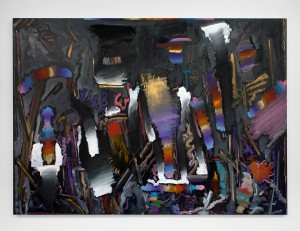Painting a Colorful Reality with Lori Hyland
Some abstract artists do not contemplate over their choice of color when dipping their paintbrush before that swift, almost dance like movement of the wrist splatters monochromatic hues on the previously white canvas, creating a unique pattern. Such is not the case for Californian based painter Lori Hyland for whom the choice of color is a continuous dialogue between the painting and herself in an attempt of unveiling the symbolism of the world around her. She is a woman of allegory, telling tales through the dissection of her personal reality entwined with cultural, geographical, and astronomical influences.
Her paintings are lively, provocative, and expressionistic, full of bold colors and hidden intricacies that though hard to distinguish at times, speak volumes of the representation of the painting that one might not have singularized from the title of the work; one might even compare them to a jazz composition with its vibrant melodies of solo improvisational acts coming together into one great artistic work. In fact, a few of her paintings have been dedicated to such arrangements such as her Jazz Improv painting, which if looked upon closely, seems to showcase guitar frets sticking out amongst other instruments as well as a slightly disorganized nature that can easily be attributed to solo acts. But her paintings are anything but disorganized – they’re meticulously well thought out in terms of movement and pattern –and are a journey into the constantly changing realm that we live in; a manifestation of the truth.
With various exhibitions across the United States and Europe, including her recent exhibit during the Scope show in Miami, and demands for her artwork from galleries, it is hard to believe that the woman who enjoys singing the blues during her free time, only started painting professionally four to five years ago. Yet despite her limited time in the art world, Hyland has had years of classical training ranging from her time at the Pratt Institute to the School of Visual Art in New York, where she developed her basic skills into the ones that are visible today. And as her paintings continue to grow in structure and meaning, so does her education, for according to Hyland, an artist’s enlightenment never ends, it merely begins from the moment one picks up the paintbrush.
GALO: For someone who only started painting four to five years ago, your polychromatic artwork is powerful and bold, creating an emotional rippling effect with each splash of color. Why did you choose this form of art (or did it choose you) and how did your inclination toward painting first begin?
Lori Hyland: I see the world through color and that includes music as well. Color is seen in all forms of life; grey skies and deserts – all is color. Internal and external reality creates and evokes color. Painting is just an extension of my personal reality. Nothing is contrived; it just happens, although in a disciplined manner which is my nature and classical training.
GALO: Though abstract art is undeniably vibrant and a form of self-expression, there are many who are still astounded by it. What do you say to those who have a hard time understanding the abstract form?
LH: I suggest they look at art in all its forms and permutations. It does not necessarily need to be in a museum or gallery. One should look without judgment, bypassing the accepted mental roadblocks of what is good art or duplicates reality as the viewer perceives. Gradually, your eye will become informed, and what initially may seem inaccessible will become meaningful; if one persists, even the most abstract and impenetrable forms will gradually become meaningful.
GALO: I read that you were first inspired by spirituality and then jazz music. Do you currently have a new inspiration?
LH: Yes, and I’m glad you asked. I’ve recently been presented with hieroglyphics; brilliant, modern, and universally meaningful through all millennia and cultures. They were claimed to be rock-carvings millions of years in age. The title [of my recent series inspired by these]: Ancient Memories-Modern Expression.
GALO: Jazz music is quite improvisational at times and free-flowing, so to speak, much like your art. Do you find yourself replicating the sounds on canvas – perhaps following the musical movements with your brush?
LH: In a way, I’m the “Jazz Artist” as well, improvising with my “brush.”
GALO: You’ve expressed that in order for you to become an artist, you immersed yourself in classical art as well as its fundamentals. Why is this of importance for someone who wants to pursue an artistic profession?
LH: I believe in any pursuit, creative or professional, you learn the basics first — limitations, how to use the materials; once learned, you have the basic structure to be free.
(Article continued on next page)

